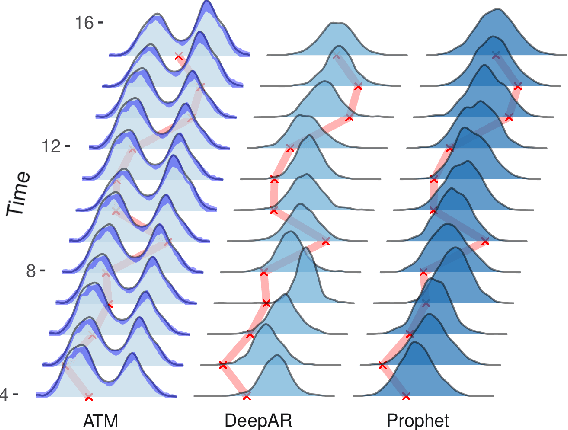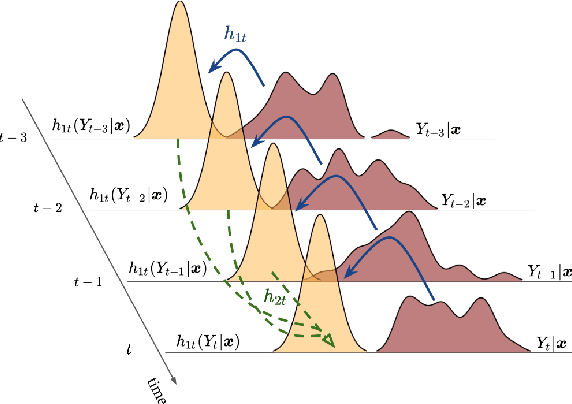Thomas Kneib
Probabilistic Topic Modelling with Transformer Representations
Mar 06, 2024Abstract:Topic modelling was mostly dominated by Bayesian graphical models during the last decade. With the rise of transformers in Natural Language Processing, however, several successful models that rely on straightforward clustering approaches in transformer-based embedding spaces have emerged and consolidated the notion of topics as clusters of embedding vectors. We propose the Transformer-Representation Neural Topic Model (TNTM), which combines the benefits of topic representations in transformer-based embedding spaces and probabilistic modelling. Therefore, this approach unifies the powerful and versatile notion of topics based on transformer embeddings with fully probabilistic modelling, as in models such as Latent Dirichlet Allocation (LDA). We utilize the variational autoencoder (VAE) framework for improved inference speed and modelling flexibility. Experimental results show that our proposed model achieves results on par with various state-of-the-art approaches in terms of embedding coherence while maintaining almost perfect topic diversity. The corresponding source code is available at https://github.com/ArikReuter/TNTM.
TreeLearn: A Comprehensive Deep Learning Method for Segmenting Individual Trees from Forest Point Clouds
Sep 15, 2023Abstract:Laser-scanned point clouds of forests make it possible to extract valuable information for forest management. To consider single trees, a forest point cloud needs to be segmented into individual tree point clouds. Existing segmentation methods are usually based on hand-crafted algorithms, such as identifying trunks and growing trees from them, and face difficulties in dense forests with overlapping tree crowns. In this study, we propose \mbox{TreeLearn}, a deep learning-based approach for semantic and instance segmentation of forest point clouds. Unlike previous methods, TreeLearn is trained on already segmented point clouds in a data-driven manner, making it less reliant on predefined features and algorithms. Additionally, we introduce a new manually segmented benchmark forest dataset containing 156 full trees, and 79 partial trees, that have been cleanly segmented by hand. This enables the evaluation of instance segmentation performance going beyond just evaluating the detection of individual trees. We trained TreeLearn on forest point clouds of 6665 trees, labeled using the Lidar360 software. An evaluation on the benchmark dataset shows that TreeLearn performs equally well or better than the algorithm used to generate its training data. Furthermore, the method's performance can be vastly improved by fine-tuning on the cleanly labeled benchmark dataset. The TreeLearn code is availabe from https://github.com/ecker-lab/TreeLearn. The data as well as trained models can be found at https://doi.org/10.25625/VPMPID.
Neural Additive Models for Location Scale and Shape: A Framework for Interpretable Neural Regression Beyond the Mean
Jan 27, 2023Abstract:Deep neural networks (DNNs) have proven to be highly effective in a variety of tasks, making them the go-to method for problems requiring high-level predictive power. Despite this success, the inner workings of DNNs are often not transparent, making them difficult to interpret or understand. This lack of interpretability has led to increased research on inherently interpretable neural networks in recent years. Models such as Neural Additive Models (NAMs) achieve visual interpretability through the combination of classical statistical methods with DNNs. However, these approaches only concentrate on mean response predictions, leaving out other properties of the response distribution of the underlying data. We propose Neural Additive Models for Location Scale and Shape (NAMLSS), a modelling framework that combines the predictive power of classical deep learning models with the inherent advantages of distributional regression while maintaining the interpretability of additive models.
Bayesian Discrete Conditional Transformation Models
May 17, 2022



Abstract:We propose a novel Bayesian model framework for discrete ordinal and count data based on conditional transformations of the responses. The conditional transformation function is estimated from the data in conjunction with an a priori chosen reference distribution. For count responses, the resulting transformation model is novel in the sense that it is a Bayesian fully parametric yet distribution-free approach that can additionally account for excess zeros with additive transformation function specifications. For ordinal categoric responses, our cumulative link transformation model allows the inclusion of linear and nonlinear covariate effects that can additionally be made category-specific, resulting in (non-)proportional odds or hazards models and more, depending on the choice of the reference distribution. Inference is conducted by a generic modular Markov chain Monte Carlo algorithm where multivariate Gaussian priors enforce specific properties such as smoothness on the functional effects. To illustrate the versatility of Bayesian discrete conditional transformation models, applications to counts of patent citations in the presence of excess zeros and on treating forest health categories in a discrete partial proportional odds model are presented.
Distributional Gradient Boosting Machines
Apr 02, 2022



Abstract:We present a unified probabilistic gradient boosting framework for regression tasks that models and predicts the entire conditional distribution of a univariate response variable as a function of covariates. Our likelihood-based approach allows us to either model all conditional moments of a parametric distribution, or to approximate the conditional cumulative distribution function via Normalizing Flows. As underlying computational backbones, our framework is based on XGBoost and LightGBM. Modelling and predicting the entire conditional distribution greatly enhances existing tree-based gradient boosting implementations, as it allows to create probabilistic forecasts from which prediction intervals and quantiles of interest can be derived. Empirical results show that our framework achieves state-of-the-art forecast accuracy.
Transforming Autoregression: Interpretable and Expressive Time Series Forecast
Oct 15, 2021



Abstract:Probabilistic forecasting of time series is an important matter in many applications and research fields. In order to draw conclusions from a probabilistic forecast, we must ensure that the model class used to approximate the true forecasting distribution is expressive enough. Yet, characteristics of the model itself, such as its uncertainty or its general functioning are not of lesser importance. In this paper, we propose Autoregressive Transformation Models (ATMs), a model class inspired from various research directions such as normalizing flows and autoregressive models. ATMs unite expressive distributional forecasts using a semi-parametric distribution assumption with an interpretable model specification and allow for uncertainty quantification based on (asymptotic) Maximum Likelihood theory. We demonstrate the properties of ATMs both theoretically and through empirical evaluation on several simulated and real-world forecasting datasets.
Boosting Joint Models for Longitudinal and Time-to-Event Data
Dec 22, 2016



Abstract:Joint Models for longitudinal and time-to-event data have gained a lot of attention in the last few years as they are a helpful technique to approach common a data structure in clinical studies where longitudinal outcomes are recorded alongside event times. Those two processes are often linked and the two outcomes should thus be modeled jointly in order to prevent the potential bias introduced by independent modelling. Commonly, joint models are estimated in likelihood based expectation maximization or Bayesian approaches using frameworks where variable selection is problematic and which do not immediately work for high-dimensional data. In this paper, we propose a boosting algorithm tackling these challenges by being able to simultaneously estimate predictors for joint models and automatically select the most influential variables even in high-dimensional data situations. We analyse the performance of the new algorithm in a simulation study and apply it to the Danish cystic fibrosis registry which collects longitudinal lung function data on patients with cystic fibrosis together with data regarding the onset of pulmonary infections. This is the first approach to combine state-of-the art algorithms from the field of machine-learning with the model class of joint models, providing a fully data-driven mechanism to select variables and predictor effects in a unified framework of boosting joint models.
 Add to Chrome
Add to Chrome Add to Firefox
Add to Firefox Add to Edge
Add to Edge